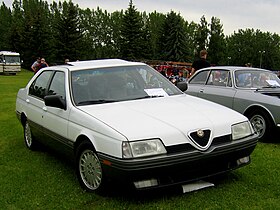Alfa Romeo 164
| Alfa Romeo 164 | |
|---|---|
 |
|
| Overview | |
| Manufacturer | Alfa Romeo |
| Also called | Alfa Romeo 168 |
| Production | 1987–1998 |
| Assembly | Arese, Milan, Italy |
| Designer | Enrico Fumia (Pininfarina) |
| Body and chassis | |
| Class | Mid-size luxury / Executive car (E) |
| Body style | 4-door saloon |
| Layout | Front-engine, front-wheel-drive / four-wheel-drive |
| Platform | Type Four platform |
| Related |
Lancia Thema Saab 9000 |
| Powertrain | |
| Engine |
|
| Transmission | 5-speed manual 6-speed Getrag manual 4-speed ZF 4HP18Q automatic 4-speed ZF 4HP18QE automatic |
| Dimensions | |
| Wheelbase | 2,660 mm (104.7 in) |
| Length | 4,554 mm (179.3 in) (1988–90) 4,557 mm (179.4 in) (1991–92) 4,560 mm (179.5 in) (1993–94) 4,665 mm (183.7 in) (Super) |
| Width | 1,760 mm (69.3 in) |
| Height | 1,390 mm (54.7 in) (1988–90) 1,393 mm (54.8 in) (1991–92) 1,390 mm (54.7 in) (1993–95) |
| Kerb weight | 1,200–1,510 kg (2,650–3,330 lb) |
| Chronology | |
| Predecessor |
Alfa Romeo 90 Alfa Romeo Alfa 6 |
| Successor | Alfa Romeo 166 |
The Alfa Romeo 164 (codenamed Type 164) is a four-door executive saloon that was manufactured by the Italian automaker Alfa Romeo from 1987 to 1998 and designed by Pininfarina. Its predecessors of the 164 was the Alfetta, and its Alfa 6 derivative. It was superseded by the 166 in 1998, after a total of 273,857 domestic and export 164 units.
In October 1978, Alfa Romeo, Fiat, Lancia and Saab jointly agreed to each develop an executive saloon based on their shared Type Four platform ("Tipo 4" in Italian), to eventually compete against the likes of the Ford Granada and Opel Rekord (Vauxhall Carlton) as well as more premium saloons by BMW and Mercedes-Benz in the form of the 5-Series and E-Class, respectively.
Project 164 started life as Project 154 and was completed in 1981, then still under Alfa Romeo. A year later, that project morphed into the 164 based on the Type Four platform. This new model was designed by Enrico Fumia of Pininfarina, with a wedge shape that afforded it a leading drag coefficient of Cd=0.30. The design would later influence the rest of the Alfa Romeo range (starting in 1990 with the major redesign of the 33 and culminating with the 155, and also see Pininfarina adapt it for the 1987 Peugeot 405 and the 1989 Peugeot 605 sedans).
...
Wikipedia
